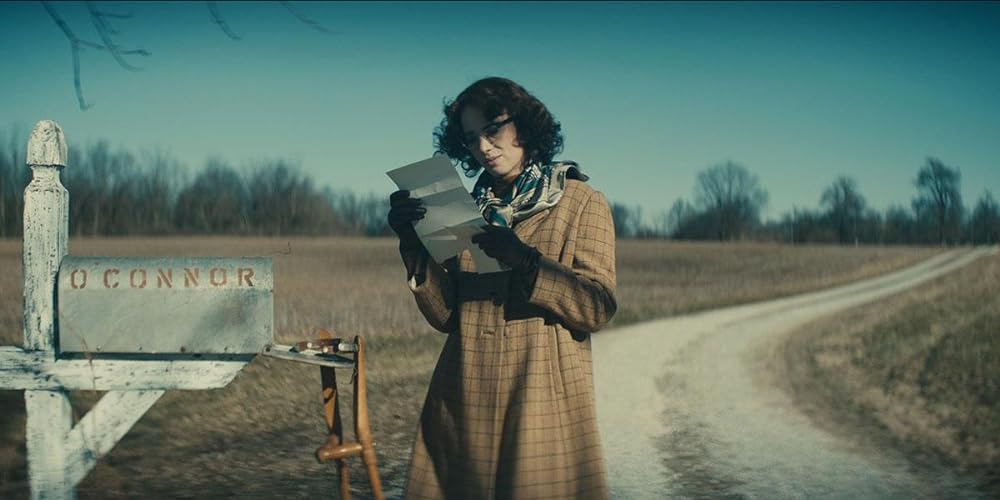Few people in Flannery O’Connor’s life seem to enjoy her stories—at least according to Wildcat, the new biopic about the acclaimed Southern gothic writer. Her mother wonders why she can’t write “nice stories.” A family friend asks for “cute stories.” Even her editor complains that her stories feel like they’re sticking pins in the reader. And to be fair, these are indeed troubling stories filled with grotesque characters: a puritanical wife who beats her husband with a broom after he gets a tattoo of Christ on his back, for example, or a traveling Bible salesman who preys on disabled people and collects their prosthetics as trophies.
But as illuminated in director Ethan Hawke’s film, O’Connor wanted her stories to both afflict her readers and even to make them laugh—it was the only path she could see to save them, and herself. Likewise, Wildcat is a film that can afflict and perhaps even help save its viewers, too.
If you have never read a Flannery O’Connor story, here’s a flavor of what to expect: Picture a genteel white woman in a doctor’s office who is passing the time by musing to herself about how best to rank those around her based on … race and class. At the bottom of the pile are the Negroes (and here the genteel woman, Mrs. Turpin, uses a different word). Then there’s the “white trash,” then the landless white homeowners, and then the white landowners. Now, Negroes with land are clearly better than Negroes without land—but how do they rank compared to the white homeowners who lack land? It all starts to get so complex! Add Jesus to the mix (need I explain that he is white?) appearing in her daydream and explaining that there’re only two positions left in heaven, and you either have to be a Negro or white trash. “No, Jesus, please say it isn’t so!”
The scene, taken from one of O’Connor’s short stories, “Revelation,” is just one of the few brilliantly rendered depictions in Wildcat. If either as a reader or viewer you find yourself laughing, squirming, and thinking about how ridiculous it is to superficially classify ourselves and others—congratulations! You’ve engaged with O’Connor in the exact way she would have wanted.
Wildcat is about the writer as much as it is about her stories. As a biopic, the film carefully explores O’Connor’s struggles to hone her craft while also wrestling with faith, doubt, and pride. “Make me your typewriter,” O’Connor prays in one scene, while also later confessing to her priest that her truer motivation is to become an acclaimed author. With a similarly unflinching candor, the film documents O’Connor’s battle with lupus, which forces her to leave her friends and love interest in the Northeast and move back home to rural Georgia, where she eventually died at the age of only 39. And yes, O’Connor certainly skewers racists in her stories—but she also skewers pretentious young ladies who go off to the North to get educated and then come back as arrogant and contemptuous of their provincial mothers. Let the reader understand.
Maya Hawke, who plays O’Connor and several of her stories’ protagonists, was first introduced to O’Connor’s writings in high school by an English teacher. She and her father Ethan draw on the full breadth of O’Connor’s prayer journal, letters, and essays to anchor the biographical details, develop an authentic sense of O’Connor’s interiority, and even as the basis for a substantial amount of the film’s dialogue. As several of O’Connor’s stories are brought to life, the film invites us to see how these biographic details likely shaped O’Connor’s imagination and writing.
But while the biography gives some insight into the stories, Wildcat makes clear that O’Connor’s faith was the true animating principle of her art. All of her stories are about moments of grace where the divine intrudes, often comically, sometimes violently, in the lives of everyday people, many of whom believe themselves righteous, but all of whom are in desperate need of salvation. In one of the film’s scenes—which uses dialogue quoted verbatim from one of her essays —O’Connor laments that “what people don’t realize is how much religion costs. They think faith is a big electric blanket, when of course it is the cross.”
All of us can be tempted to water down the Gospel into a palatable, uplifting story. For O’Connor, this was especially the case in the “Christ-haunted” South, where so many of her fellow “good country people” dressed up for church on Sundays but would fail to see Christ in the faces of those around them. “Nice stories” in this context would merely reinforce the desire for comfort and evade the need for the cross.
At the end of “Revelation,” Mrs. Turping gets smacked upside the head by a book (the discerning eye notes the book title, Human Development) while being called a “warthog from hell” by a character named Mary Grace. In a voiceover, O’Connor narrates a revelatory vision in which the respectable class of churched folks like Mrs. Turpin, marked by their “good order and common sense and respectable behavior” march at the back of a procession to heaven, with “shocked and altered faces” as “even their virtues were being burned away.” The episode echoes a passage from Corinthians, in which St. Paul writes that in the final judgment some will “suffer loss but yet will be saved—even though only as one escaping through the flames.” It’s also reminiscent of the modernist poet T.S. Eliot, who writes of this purification process and its painful revelations, in the final movement of The Fourth Quartets. Eliot describes
the rending pain of re-enactment
Of all that you have done, and been; the shame
Of things ill done and done to others' harm
Which once you took for exercise of virtue.
In all three texts, good works and presumed piety are instead revealed as mere straw. Like Mrs. Turpin, we are just barely saved, with a painful transformation that lays bare our true miserable condition.
While many sins can lead to “things ill done and done to others’ harm,” racism is a particularly important one to consider given the historical and geographic context of O’Connor’s life and writing in the Jim Crow South. Indeed, though not depicted within the film, O’Connor herself was not immune to the sickness of racism, confessing to one friend that “I’m an integrationist by principle & and a segregationist by taste.” Just like the fictional Mrs. Turpin, the real-life O’Connor also ranked people according to prejudice. In one letter, O’Connor even complained “About the Negroes, the kind I don’t like is the philosophizing prophesying pontificating kind, the James Baldwin kind. Very ignorant but never silent.”
Ironically, Baldwin’s writing has striking similarities to O’Connor’s in terms of forcing a confrontation with reality. In his poignant letter to his nephew, Baldwin writes that “if the word ‘integration’ means anything, this is what it means, that we with love shall force our [white] brothers to see themselves as they are, to cease fleeing from reality and begin to change it.”
Here, grace as a conduit of both personal and cultural transformation is an exercise of love. But true to O’Connor’s own vision, and keeping with Eliot and St. Paul, it’s a grace that first burns away false perceptions and false virtues.
Whether our sin is racism or pride, hatred or lust, sloth or greed, it is the loving intrusion of God’s grace that shatters our complacency and makes us reckon with the darkness lurking within our own hearts. And often this grace is mediated to us through the very people that we despise or ignore.
For Wildcat, the path toward salvation is not found through human efforts to better ourselves, whether in our own eyes or in the eyes of our peers. Rather, salvation is found in moments of encounter, those where grace violently burns away our illusions, deceptions, and lies, allowing us to face reality and recognize our own desperate need for God. O’Connor seems to tell us that it is precisely in those moments of humility, as we come to grips with our sin as our own chronic illness, that Christ is waiting, ready to heal.






Please note that we at The Dispatch hold ourselves, our work, and our commenters to a higher standard than other places on the internet. We welcome comments that foster genuine debate or discussion—including comments critical of us or our work—but responses that include ad hominem attacks on fellow Dispatch members or are intended to stoke fear and anger may be moderated.
With your membership, you only have the ability to comment on The Morning Dispatch articles. Consider upgrading to join the conversation everywhere.